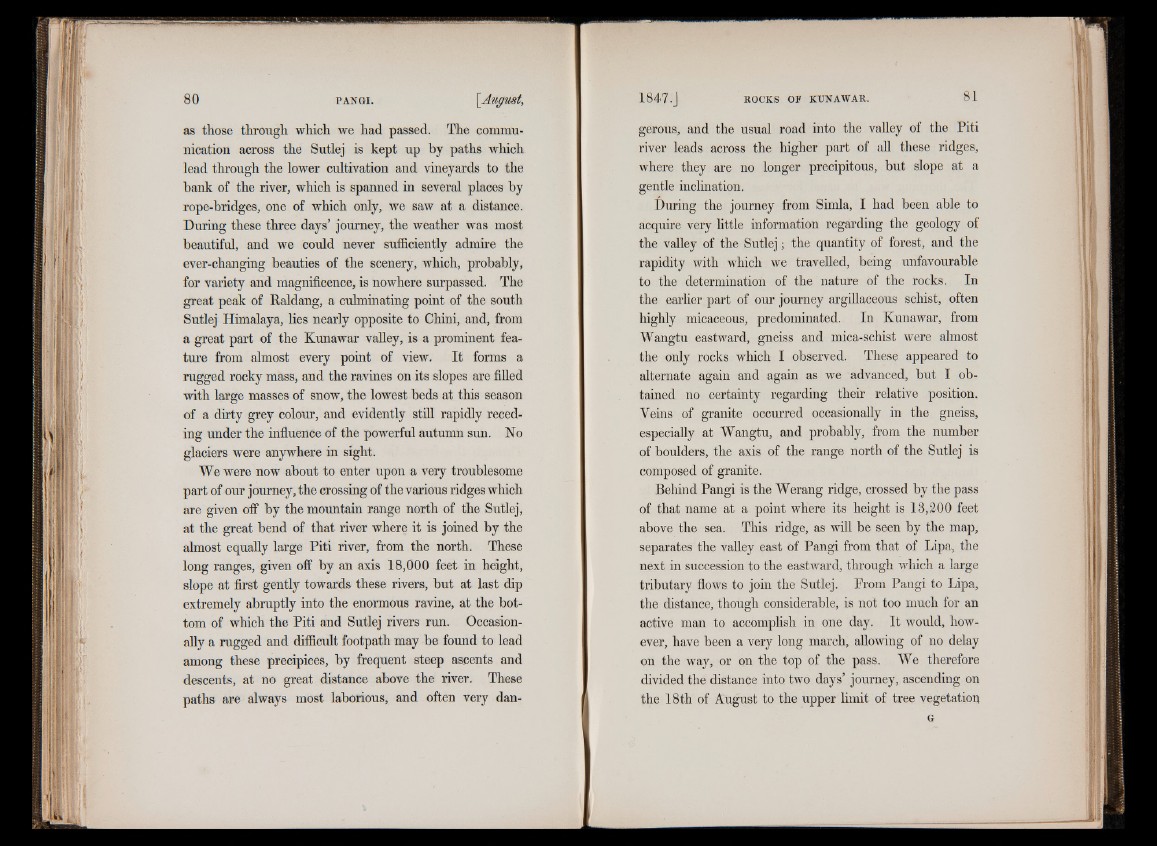
80 PANGI. [August,
as those through which we had passed. The communication
across the Sutlej is kept up by paths which
lead through the lower cultivation and vineyards to the
bank of the river, which is spanned in several places by
rope-bridges, one of which only, we saw at a distance.
During these three days’ journey, the weather was most
beautiful, and we could never sufficiently admire the
ever-changing beauties of the scenery, which, probably,
for variety and magnificence, is nowhere surpassed. The
great peak of Raldang, a culminating point of the south
Sutlej Himalaya, lies nearly opposite to Chini, and, from
a great part of the Kunawar valley, is a prominent feature
from almost every point of view. It forms a
rugged rocky mass, and the ravines on its slopes are filled
with large masses of snow, the lowest beds at this season
of a dirty grey colour, and evidently still rapidly receding
under the Influence of the powerful autumn sun. No
glaciers were anywhere in sight.
We were now about to enter upon a very troublesome
part of our journey, the crossing of the various ridges which
are given off by the mountain range north of the Sutlej,
at the great bend of that river where it is joined by the
almost equally large Piti river, from the north. These
long ranges, given off by an axis 18,000 feet in height,
slope at first gently towards these rivers, but at last dip
extremely abruptly into the enormous ravine, at the bottom
of which the Piti and Sutlej rivers run. Occasionally
a rugged and difficult footpath may be found to lead
among these precipices, by frequent steep ascents and
descents, at no great distance above the river. These
paths are always most laborious, and often very dan1847.
J ROCKS OF KUNAWAR. 81
gerous, and the usual road into the valley of the Piti
river leads across the higher part of all these ridges,
where they are no longer precipitous, but slope at a
gentle inclination.
During the journey from Simla, I had been able to
acquire very little information regarding the geology of
the valley of the Sutlej; the quantity of forest, and the
rapidity with which we travelled, being unfavourable
to the determination of the nature of the rocks. In
the earlier part of our journey argillaceous schist, often
highly micaceous, predominated. In Kunawar, from
Wangtu eastward, gneiss and mica-schist were almost
the only rocks which I observed. These appeared to
alternate again and again as we advanced, but I obtained
no certainty regarding their relative position.
Veins of granite occurred occasionally in the gneiss,
especially at Wangtu, and probably, from the number
of boulders, the axis of the range north of the Sutlej is
composed of granite.
Behind Pangi is the Werang ridge, crossed by the pass
of that name at a point where its height is 13,200 feet
above the sea. This ridge, as will be seen by the map,
separates the valley east of Pangi from that of Lipa, the
next in succession to the eastward, through which a large
tributary flows to join the Sutlej. Prom Pangi to Lipa,
the distance, though considerable, is not too much for an
active man to accomplish in one day. It would, however,
have been a very long march, allowing of no delay
on the way, or on the top of the pass. We therefore
divided the distance into two days’ journey, ascending on
the 18th of August to the upper limit of tree vegetation
G